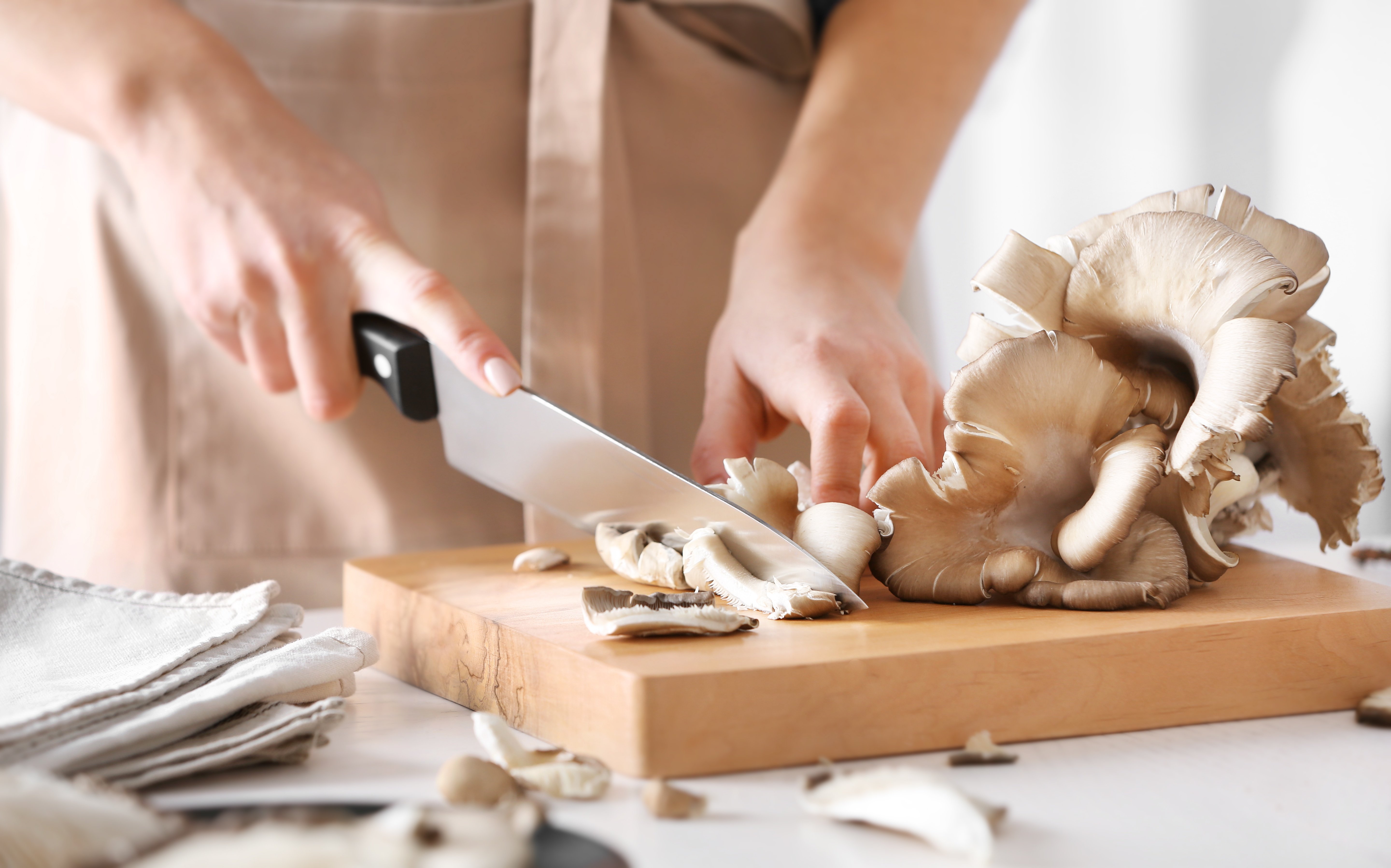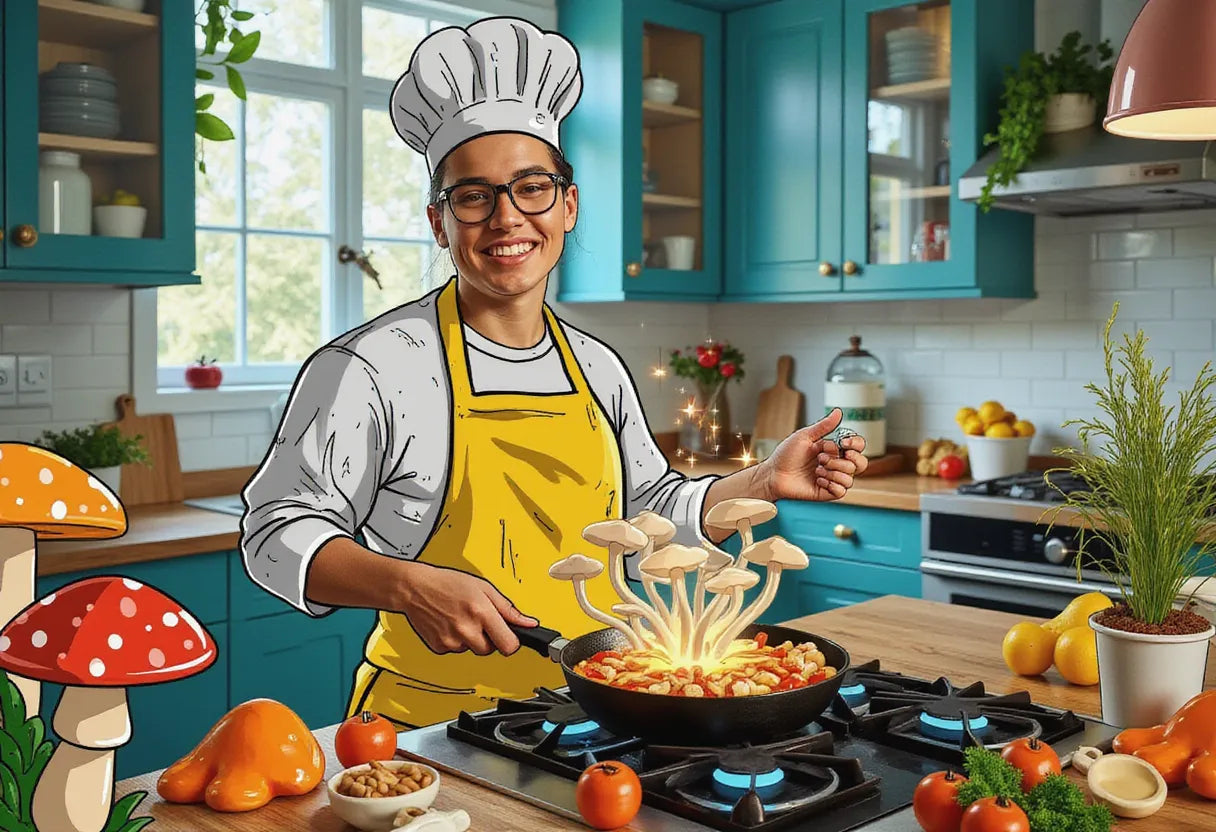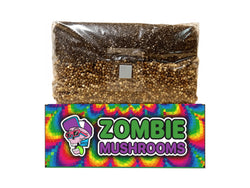⬇️ Prefer to listen instead? ⬇️
- Frozen mushrooms keep most of their key nutrients even after being stored a long time.
- Cooking methods that use high heat like sautéing and roasting get the best texture and flavor.
- Cooking mushrooms a little bit before freezing makes them much better after you thaw them.
- You usually don't need to thaw them—frozen mushrooms can go right into hot dishes.
- Common kinds like cremini, oyster, and shiitake freeze well and don't lose much texture.
Fresh mushrooms are used a lot in cooking because they taste earthy and you can use them in many ways—but they don't last long, which can be annoying. Freezing mushrooms is a good idea for the kitchen. It keeps them ready to cook, saves time and money, and means you throw away less food. This article explains how to cook frozen mushrooms, the best ways to freeze them, what kinds freeze best, and cooking tips to get tasty results.

Mushrooms Hold Up Nutritionally, Even After Freezing
Many people wonder if freezing mushrooms makes them less healthy. But mushrooms keep most of their good nutrients, even after being frozen. The USDA (2020) says mushrooms are still a good source of
- B vitamins like riboflavin, niacin, and pantothenic acid
- Selenium, a powerful antioxidant
- Potassium, important for muscle and nerve function
- Fiber to support digestion and heart health
- Beta-glucans and other immune-boosting compounds
Mushrooms are more than 90% water, so their texture changes a bit when frozen—but studies show their main nutrients don't go down much. Because of this, freezing mushrooms is a good way to keep their health benefits, especially if you use them often as part of a healthy or plant-based diet.

Prepping Your Mushrooms for the Freezer
Getting your mushrooms ready the right way is important so they cook well after freezing. Follow these steps to keep them from getting soggy and to help them keep their texture
Clean Properly
Never put your mushrooms in water for long—they will soak up too much water. Instead
- Gently brush off visible dirt with a damp paper towel or soft brush.
- If needed, give a light rinse and pat dry thoroughly with a clean cloth.
Trim and Slice
- Cut off tough or dirty ends of the stems.
- Cutting bigger mushrooms like portobello or shiitake into pieces that are about the same size helps them freeze and cook more evenly.
Par-cook Before Freezing
This is a common mistake: raw mushrooms don't freeze well. They have a lot of water, which makes them mushy if you freeze them raw. Experts at the National Center for Home Food Preservation (2022) suggest par-cooking them a little to keep their shape and flavor.
Best Par-Cooking Methods
- Sautéing: Cook lightly in oil or butter over medium heat for 5–7 minutes, just until tender.
- Steaming: Steam whole or sliced mushrooms for 2–3 minutes, then cool quickly in an ice bath.
After they are cool and drained, spread the mushrooms on a baking sheet. Freeze them flat for a few hours, and then put them into containers that won't let air in or freezer bags that seal well. This stops them from sticking together and getting freezer burn.

Thawing: Is It Even Necessary?
A big plus about cooking frozen mushrooms is that you usually don’t need to thaw them at all.
Skip Thawing For
- Stir-fries
- Sautéed dishes
- Roasted vegetables
- Soups or stews
Putting frozen mushrooms right into a hot pan helps the water disappear quickly and makes the texture better. Just make sure to use high heat and don’t put too many in the pan at once.
When to Thaw
You might want to thaw mushrooms quickly if you're adding them to dishes that need a softer texture (like quiches, casseroles, or omelets)
- Use your microwave in 30-second steps.
- Or move them to the refrigerator overnight.
You should use thawed mushrooms within a day so they don’t lose texture.

Best Ways to Cook Frozen Mushrooms
It doesn't matter if you're using frozen mushrooms from the store or your own freezer bag, how you cook them changes everything.
Sautéing
This way of cooking gives the most flavor and works for many dishes
- Heat your skillet over medium-high heat.
- Add a little oil or butter.
- Toss in frozen mushrooms directly—no need to thaw.
- Stir sometimes and let them release their water.
- Keep cooking until the water goes away and mushrooms start to brown (about 8–10 minutes).
- Season only after most water is gone to make the flavor stronger.
Roasting
This is great when you don't want to stand over the stove
- Heat oven to 400°F (204°C).
- Spread frozen mushrooms in one layer on a baking sheet with parchment paper.
- Mix lightly with olive oil, salt, and pepper.
- Roast for 20–25 minutes, stirring halfway through until edges start to get crisp.
Soups and Stews
Frozen mushrooms are great to add here
- No need to thaw—just drop them into your pot as it simmers.
- Their water makes broth-based or creamy soups better.
- You can use them in popular dishes like mushroom barley soup, wild rice soup, and beef stew.
Stir-fries
For meals that are fast and healthy
- Add frozen mushrooms near the end of cooking.
- Doing this keeps your stir-fry sauce from getting too watery.
- Put them with crisp vegetables and protein like tofu, shrimp, or chicken.
Grilling or Pan-Seared
For special mushrooms like lion’s mane or maitake
- Thaw first if you're using the grill so they cook the same all the way through.
- Press gently to get rid of extra water before searing or grilling them in oil or butter.

Flavor and Texture: What to Expect
Do frozen mushrooms taste the same as fresh ones? Not exactly—but they taste pretty close if you cook them the right way.
Texture
- They are a bit softer than fresh ones because water expands when it freezes.
- Don't boil them and use high heat. This helps them feel best in your mouth and taste savory (umami).
Flavor
- They taste earthy and strong.
- Mild mushrooms like white buttons taste better if you add herbs, garlic, or soy sauce.
- Special mushrooms like shiitake or oyster keep their own taste better after freezing.
The main thing is to get rid of water while cooking and put them with foods that make them taste rich.

Delicious Ways to Use Them
Want to try cooking frozen mushrooms in new ways? Here are many ideas to try
- Pasta & Risottos: Stir into creamy risottos or linguine with garlic, cream, and peas.
- Egg Dishes: Fold into scrambled eggs, quiches, or breakfast burritos.
- Pizza Toppings: Layer over mozzarella and marinara before baking.
- Meatloaf & Burgers: Mix into ground meat for juicy, nutrient-rich patties.
- Grain Bowls: Add to quinoa or brown rice with sautéed greens and tahini sauce.
- Toast & Galettes: Top crusty bread, or layer into savory pies with cheese.
Because you can use them in so many ways, cooking frozen mushrooms is great for busy weeknight meals or trying new things on the weekend.

You Can Blend Them
Blending frozen mushrooms isn’t just something you can do—it works really well.
- Soups and Gravies: Add sautéed mushrooms to your blender or food processor with broth for rich, creamy results.
- Plant-Based Blends: Mix cooked mushrooms with black beans or lentils to create hearty veggie burgers or meatballs.
- Smoothies: Try bold mixes with cocoa, banana, and pre-sautéed lion’s mane or adaptogenic mushroom blends. The umami goes well with bitter and nutty flavors surprisingly well.
Blended mushrooms are also a good way to hide extra veggies for picky eaters.

Short-Term Storage Alternative: Marinating
Don’t want to freeze but still want to keep them longer? Try marinating:
How to Marinate Mushrooms
- Cook clean sliced mushrooms lightly in olive oil.
- Let cool a little.
- Add vinegar (like balsamic or red wine), garlic, herbs (like thyme or rosemary), and salt.
- Keep in a sealed jar for up to 5 days in the fridge.
These marinated mushrooms are great for salads, cheese boards, antipasto, or even toast for breakfast.

Mistakes to Avoid When Cooking Frozen Mushrooms
To get the best results with your mushrooms, don't make these common mistakes
- Putting too many in the pan = steamed, soggy results.
- Using low heat = limp, watery mushrooms with no browning.
- Letting thawed mushrooms sit = makes them too wet and they spoil.
- Freezing raw mushrooms = mushy texture after defrosting.
Knowing how to use high heat and getting them ready the right way makes all the difference in getting mushrooms that taste as good as a restaurant's at home.
Why Freezing Mushrooms Makes Sense for Sustainability and Savings
Freezing mushrooms isn’t just easy—it’s good for the planet and saves you money.
Sustainability
- Cuts down on food waste by making mushrooms last longer.
- Helps keep edible fungi from home gardens or local markets from going bad.
- Lets you plan better and means you forget fewer things in the fridge.
Savings
- Buying mushrooms in bulk or when they are on sale becomes easy and smart.
- Frozen mushrooms mean you don't need to go to the grocery store as often.
- People who grow mushrooms at home or find them in nature can keep big amounts for a long time.
Doing this fits with modern ways to waste less in the kitchen, which are good for your money and the planet.

What Types of Mushrooms Freeze Best?
Some kinds handle freezing better because of how firm they are, how much water they have, and their shape.
Top Performers
- Button & Cremini: Hold up well when sliced and cooked lightly.
- Oyster & Shiitake: Keep flavor and texture nicely.
- Lion’s Mane & Maitake: Great if you eat them for health; are better if they are par-cooked before freezing.
Less Ideal
- Enoki Mushrooms: Too soft—it's better to use them fresh.
- Whole Portobello Caps: Can get like rubber unless you slice and cook them before freezing.
Always par-cook them and don't freeze them whole (unless they are very small). This makes the taste and texture a lot better in the end.

Tips for Home Growers and Mycology Enthusiasts
Freezing is useful for people who love mushrooms and grow them at home or find them in nature.
For Growers
- Pick mushrooms just before they are fully grown for best results.
- Slice and steam or sauté before freezing.
- Use a vacuum sealer to stop freezer burn and keep the flavor in.
For Advanced Preservation
- Try Drying Them: Use a food dehydrator to dry your mushrooms. Keep in jars that seal tight. To use, add hot water for 15–30 minutes.
- Make Mushroom Powder: Grind dried mushrooms in a spice grinder. Use to season broths, gravies, and marinades.
Freezing is still the easier way to keep their shape and use them quickly for cooking during the week.
Citations
- United States Department of Agriculture. (2020). FoodData Central. Retrieved from https://fdc.nal.usda.gov/
- National Center for Home Food Preservation. (2022). Freezing Mushrooms. Retrieved from https://nchfp.uga.edu/how/freeze/mushrooms.html




